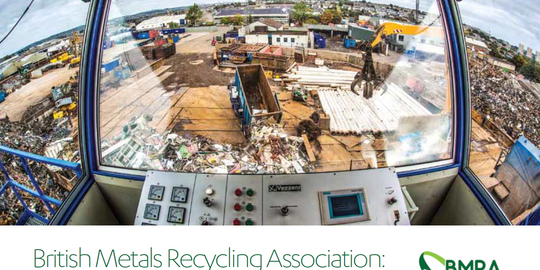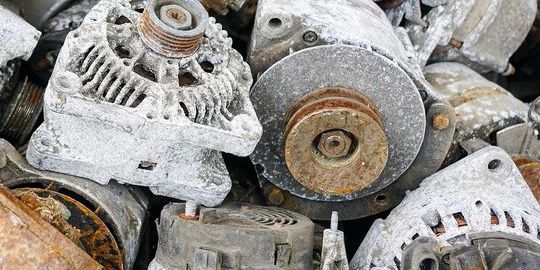11th Edition of “World Steel Recycling in Figures”
The BIR 2020 May Convention in Istanbul has been postponed to October 2020 owing to the Coronavirus pandemic. That’s why the BIR Ferrous Board today announces the publication of the 11th edition of “World Steel Recycling in Figures” during a meeting via video conference.
Divisional President Greg Schnitzer emphasizes his great pleasure in unveiling the eleventh edition of “World Steel Recycling in Figures” - a compilation of important statistics relating to the global steel scrap markets which has received a hugely positive reception since it appeared for the first time in 2010.
In this eleventh edition, final figures for 2019 show an increase in world crude steel output and in global steel scrap use as a raw material for steelmaking. At the same time, there was a drop last year in global external steel scrap trading. In difficult business times such as those triggered by the Coronavirus pandemic, the brochure highlights the positive aspects of steel recycling such as the decisive climate protection contribution of steel scrap use as a raw material in steel production.
For an even more accurate appraisal of the market, the Ferrous Division wants to continue to improve the ferrous scrap figures at its disposal, including the quarterly updates of the world statistics.
Rolf Willeke, Statistics Advisor of the BIR Ferrous Division, summarizes below the main news and findings contained in this report, which covers the five-year period from 2015 to 2019:
- Overall, the eleventh edition of the report incorporates a total of 60 graphs and tables, one more than its predecessor.
- Included is a special overview (supported by graphs) of the three leading steel scrap importers. Flow charts have been prepared for the eight main steel scrap exporters - features which have received a particularly warm welcome. Four price graphs complete this eleventh edition of the brochure.
- Global crude steel production totalled 1.870 billion tonnes in 2019, up 3.4% from the previous year. According to worldsteel, however, production contracted in all regions last year with the exception of Asia and the Middle East. Worldwide oxygen furnace production increased by 6.5% to 1.343 billion tonnes whereas the global electric furnace total was virtually unchanged at 523 million tonnes. There was a small increase in global blast furnace iron production (+2.5% to 1.278 billion tonnes) and also in DRI production (+2.4% to 90.2 million tonnes).
- Steel scrap consumption soared 15% in China last year to 215.93 million tonnes; this compares to 187.77 million tonnes in 2018 and underlines China’s position as the world’s largest steel scrap user. The increase was mainly due higher pollutant emission standards for the Chinese steel industry. Most of the country’s BOF mills have actively increased scrap inputs and their steel scrap/crude steel ratio is currently said to be 20.2%. There was also a further increase in China’s scrap-intensive electric furnace production from 54 million tonnes in 2017 to 103.2 million tonnes last year, according to worldsteel.
- Also on the increase in 2019 was steel scrap use for steelmaking in the USA (+1% to 60.7 million tonnes). Conversely, there were decreases for the EU-28 (-3.7% to 87.545 million tonnes), Japan (-7.7% to 33.684 million tonnes), Russia (-4.3% to 30.317 million tonnes), the Republic of Korea (-4.7% to 28.5 million tonnes), Turkey (-10.9% to 27.9 million tonnes) and Canada (-5.8% to 6.28 million tonnes). Last year, growth in the proportion of steel scrap used in steel production was recorded only in China (to 21.7%). In contrast, there were declines in the EU-28 (to 54.8%), the USA (to 69.1%), Japan (to 33.9%), Russia (to 42.5%), the Republic of Korea (to 33.9%), Turkey (to 82.8%) and Canada (to 49.1%).
- In 2019, there was an increase to around 491 million tonnes in the amount of steel scrap used by key countries and regions (+3.4% compared to the previous year) while related crude steel production was around 1.533 billion tonnes. In this edition of “World Steel Recycling in Figures”, Canada has been added to the list of key countries. The above total of 491 million tonnes represents verified data for 82% of global steelmaking.
Our figures provide an excellent basis for a worldwide estimate of steel scrap usage. Like worldsteel, we calculate that 630 million tonnes of steel scrap are recycled every year, saving around 950 million tonnes of CO2 emissions annually - a figure greater than the CO2 emissions of the entire EU transportation sector. Besides this significant reduction in greenhouse gas emissions, it should also be highlighted that steel recycling saves energy and conserves natural resources, thus making a decisive contribution to climate protection.
- Global annual ferrous scrap use in the world’s iron and steel foundries has been between 68.9 and 74.4 million tonnes over recent years.
- According to Official Trade Statistics/WV Stahl, global external steel scrap trade - including internal EU-28 trade - amounted to 100.4 million tonnes last year (-5.8% compared to 2018).
- Steel scrap imports
- Last year brought an 8.7% decline in Turkey’s overseas steel scrap purchases to 18.857 million tonnes. However, the data still confirm Turkey’s position as the world’s foremost steel scrap importer. The country’s main supplier was the USA (+3.6% to 3.838 million tonnes).
- India reinforced its position as the world’s second-largest steel scrap importer with an 11.4% increase in its overseas steel scrap purchases to 7.053 million tonnes. The country’s main supplier was the UK (+25.3% to 0.869 million tonnes).
- Third-placed Republic of Korea upped its scrap imports by 1.6% to 6.495 million tonnes. The country’s main supplier was Japan (-0.6% to 4.017 million tonnes).
- Also higher in 2019 were steel scrap imports into the EU-28 (+2.3% to 2.893 million tonnes), Indonesia (+4.1% to 2.614 million tonnes) and Malaysia (+56.3% to 1.532 million tonnes). In contrast, import declines were recorded by the USA (-15.1% to 4.258 million tonnes), Pakistan (-13.5% to 4.337 million tonnes), Taiwan (-2.9% to 3.523 million tonnes), Canada (-38.7% to 2.129 million tonnes) and Belarus (-14.5% to 1.280 million tonnes).
- Steel scrap exports
- The EU-28 remained the world’s leading steel scrap exporter last year in upping its outbound shipments by 0.6% to 21.793 million tonnes. Its major buyer was Turkey (-0.7% to 12.021 million tonnes).
- Last year brought an increase in US overseas steel scrap shipments of 2% to 17.685 million tonnes. Its leading buyer was also Turkey (+14.1% to 3.916 million tonnes).
- Last year, there were higher steel scrap exports from Australia (+18.1% to 2.325 million tonnes) and Japan (+15.8% to 7.657 million tonnes) whereas declines in overseas shipments were registered by Canada (-14.5% to 4.369 million tonnes), Hong Kong (-26% to 0.958 million tonnes) and Singapore (-2.1% to 0.759 million tonnes). A 27.4% decline in Russia’s outbound shipments last year to 4.059 million tonnes reflected the early effects of the government’s decision to restrict steel scrap exports through quotas from the end of August 2019.
- Most of the world’s leading steel scrap exporters are major net steel scrap exporters: last year’s export surplus was, for example, 18.9 million tonnes for the EU-28 and 13.4 million tonnes for the USA.
- Over the past 10 years, “World Steel Recycling in Figures” has illustrated the worldwide use of steel scrap as a raw material in steelworks and foundries, while also underlining that steel scrap is an ecological raw material and an internationally-traded commodity subject to world market prices.
- Mr Willeke extends his deep thanks to the BIR Ferrous Board, the BIR Secretariat and to all those supporting this publication. He offers special thanks to Daniela Entzian, the BIR Ferrous Division’s Deputy Statistics Advisor, for her excellent co-operation.



